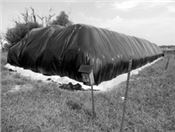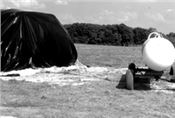Getting A Silk Purse From A Sow's Ear With Anhydrous Ammonia Treatment
MT. VERNON, MO.
Treating of low quality forages like late-cut fescue, wheat straw and fescue aftermath following seed harvest with anhydrous ammonia can be likened to making a silk purse from a sow’s ear.
“The treatment process is not a new thing. I’ve observed the process and the resulting cattle feed since the late seventies – early eighties and it really works,” said Eldon Cole, livestock specialist with University of Missouri Extension.
According to Cole, the treatment does several things to improve the forages value.
First it increases the protein value by nearly doubling it. The application level is around 2.5 to 3 percent of anhydrous ammonia for the total weight of forage in the stack. Another way of looking at it is 60 lbs. of anhydrous per ton of forage.
The treated forage tends to become softer which improves palatability and digestability. Cattle seem to love it and will clean it up better than untreated material. This improves animal intake by 20 percent.
“As far as fescue forage is concered if there is a toxicity issue, research indicates toxin levels are reduced in the treated material,” said Cole.
Another plus is the forage must be thoroughly covered with plastic so the hay or straw will be protected from the weather. If the hay is over 20 percent moisture the treatment can prevent mold formation.
The treatment process requires: a low quality forage with a neutral detergent fiber (NDF) of 70 percent or greater; a high quality plastic 6 or 8 mil thickness; anhydrous ammonia; lime or soil to hold the plastic down; and of course labor to stack and cover the bale pile.
Cole says the stack should be neat. The plastic usually comes in 40 x 100 ft. sizes so calculate the quantity of bales you can put under it. Leave ample plastic to put the lime or soil on.
“It’s best to stack, cover and apply the anhydrous as soon as possible after baling. Monitor the pile and plastic regularly to make sure there are no holes or tears in it,” said Cole. “As forage is scarce this year, there will be a lot of hay and straw harvested that would be improved with the treatment of anhydrous.”
The process does have need for caution. Anhydrous needs to be used with caution. Do not ammoniate moderate or high quality forage. Do not apply more than four percent anhydrous. Do not treat hay that’s uneven in moisture as the anhydrous will concentrate in the wet spots.
The cost of the treatment process will be variable but typically does not exceed $15 per ton of forage. ∆

Treating of low quality forages such as late-cut fescue, wheat straw and fescue aftermath following seed harvest with anhydrous ammonia can be likened to making a silk purse from a sow’s ear.
